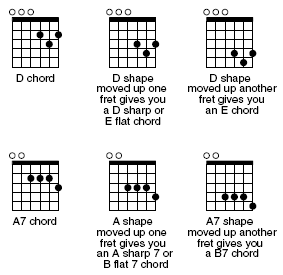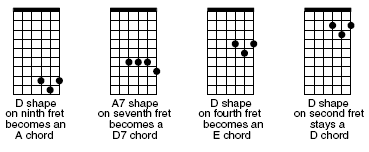A High-Note Solo
Now that weТve got down a typical rhythm part, letТs work on a highnote solo.
WeТll be using an sound that came into rockabilly mostly from the playing of Chuck
Berry. Buddy Holly used it a lot. So did the Beatles, and rock and country guitarists
continue to find new variations on it up to today.
First we need to review some of the basic theory that every guitarist must use
to navigate the fingerboardЧthe chromatic scale. Notes are named by the musical
alphabet that goes from A to G, and then starts over again. In between every letter,
except B to C and E to F, lies another note that you can call by either of two namesЧsharp
(meaning higher than) or flat (meaning lower than). Thus, the note that lies between
A and B can be called either A-sharp or B-flat. Each note, including the sharps
and flats, corresponds to one fret on the guitar.
For example, consider the A (fifth) string. The note of the open string is A,
the note on the first fret is B-flat (or A-sharp), the second fret is B, the third
fret is C, the fourth fret is D-flat, and so on. On the first or sixth strings,
both E strings, the first fret would be F, the second fret Fsharp, and so on. Each
box below represents one fret.

LetТs apply this knowledge to chord shapes. Play a D chord. There it is, with
its lowest notes on the second fret. Now move it up to the third fret. You just
made it an E-flat (or D-sharp) chord. Move it up another fret and youТll be playing
E. Play it on the fifth fret and it will become an F chord, and so on.
The same trick applies to every other chord shape. ThereТs just one thing you
have to be careful about. To keep extraneous notes out of the chord, be sure to
sound only the strings that belong to the movable chord shape that you are fretting.
DonТt sound the open strings, because they are not being moved up along with the
fingered strings. They wonТt necessarily give you the appropriate notes for the
chord. (However, sometimes the open strings sound appropriate or even weirdly interesting
along with a moved-up chord, anyway. You can experiment to find out.)

In this solo, weТll be using these basic chord shapes moved up the fingerboard:

Here goes our lead guitar solo. WeТll be sounding only the highest three strings
of the A7 chord, but if youТve already learned this chord shape covering four strings,
you may find it easier to keep fingering all four. With a flatpick, use energetic
downstrokes. If youТre playing finger style, brush down with your thumb, brush down
with the nail of your index finger (and perhaps one or more other fingers as well),
or brush up with your index finger across all three strings.
|